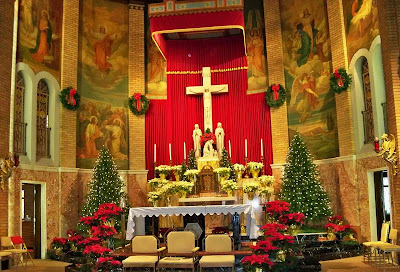 notice the double arched balcony above the sacristy doors
notice the double arched balcony above the sacristy doors  north side iconostasis balcony
north side iconostasis balcony north side icons • left panel: top: St. Teresa de Ávila, St. Joseph; bottom: St. Charles Borromeo, Archangel Raphael • right panel: St. Thérèse de Lisieux, St. Clare; St. Lawrence, Our Lady of Lourdes
north side icons • left panel: top: St. Teresa de Ávila, St. Joseph; bottom: St. Charles Borromeo, Archangel Raphael • right panel: St. Thérèse de Lisieux, St. Clare; St. Lawrence, Our Lady of Lourdes  south side icons • left panel: top: Sacred Heart of Jesus, Immaculate Heart of Mary; bottom: St. Stephen, St. Clement • right panel: St. Cyril, St. Methodius; Bl. Anton Slomšek, Ven. Frederic Baraga
south side icons • left panel: top: Sacred Heart of Jesus, Immaculate Heart of Mary; bottom: St. Stephen, St. Clement • right panel: St. Cyril, St. Methodius; Bl. Anton Slomšek, Ven. Frederic Baraga In the greek east, whether slavonic or no, whether roman or orthodox, there is an iconostasis, a screen with several, sometimes multitudinous tiered icons that runs from wall to wall. This screen has three doors. Behind it is the altar. There is always one icon of Jesus, and one of Mary, the Theotokos (Mother of God, God-bearer). Saint Lawrence, in Cleveland, Ohio, is a slovene parish. It is one of the many nationality parishes being extinguished by 'Dick the Destroyer of Parishes', Richard Lennon. One of the several points of uniqueness are the two iconostasis balconys.
The slovenes were never part of the greek church (since the schism of 1054). The slavonic nations are split between the two great halves of christianity. In the modern age, after the fall of Constantinople and the (Eastern) Roman Empire, this aspect of ecclesial architecture developed, and expanded in the east, to visually distinguish it from the west. The iconostasis divides the sanctuary from the nave. The nave (from the latin word for ship) is where the congregation sits and stands.
St. Mary's Greek Catholic (now Byzantine), Cleveland was erected under a latin-rite bishop. He did not allow an iconostasis. Since 1969, in Parma (Eparchia Parmensis Ruthenorum) there is a bishop in a byzantine eparchy, that covers the middle west, with 37 parishes and 38 priests. Many greek catholics were maltreated by latin-rite bishops in the US. Mostly irish and some german bishops were not accepting of greek and slavonic traditions. Latin rite churches, even the slavonia romana, are not locales for iconostases. But a form of one exists at St. Lawrence, whether a modified one or a hybrid one, it is there now, for the time being. It is a particularly slovene iconostasis. There depicted are westernised icons of the
 bishops Slomšek and Baraga. Both are on paths towards sainthood, further ahead than when painted, hence they are only identified as bishops. When they are canonised, they are expected to be the first slovene saints in the canon. God sends us many bishops, but few saints.
bishops Slomšek and Baraga. Both are on paths towards sainthood, further ahead than when painted, hence they are only identified as bishops. When they are canonised, they are expected to be the first slovene saints in the canon. God sends us many bishops, but few saints.
No comments:
Post a Comment